Masato Mimura
Boosting Hybrid Autoregressive Transducer-based ASR with Internal Acoustic Model Training and Dual Blank Thresholding
Sep 30, 2024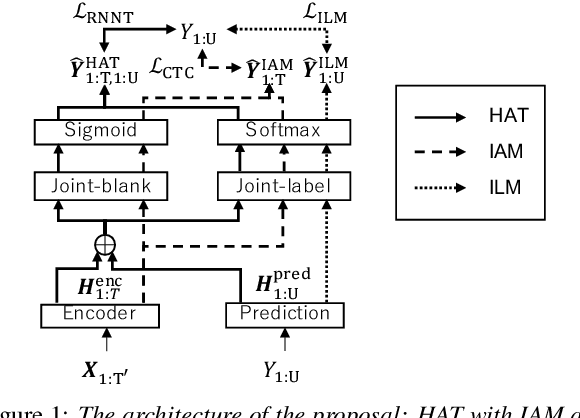
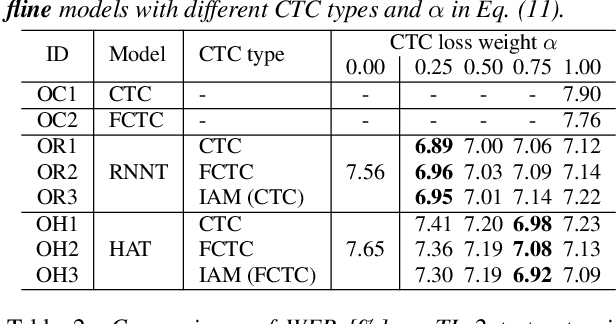
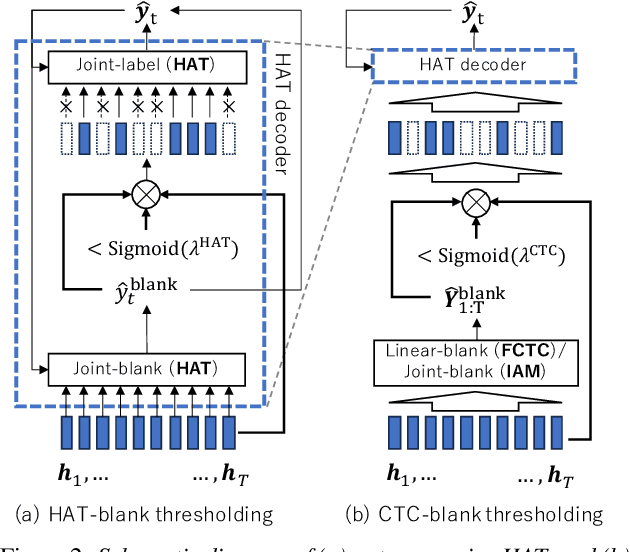
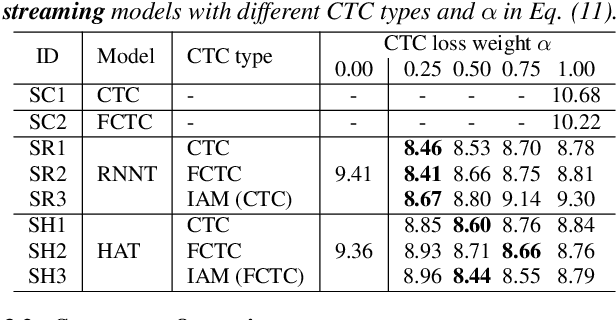
Abstract:A hybrid autoregressive transducer (HAT) is a variant of neural transducer that models blank and non-blank posterior distributions separately. In this paper, we propose a novel internal acoustic model (IAM) training strategy to enhance HAT-based speech recognition. IAM consists of encoder and joint networks, which are fully shared and jointly trained with HAT. This joint training not only enhances the HAT training efficiency but also encourages IAM and HAT to emit blanks synchronously which skips the more expensive non-blank computation, resulting in more effective blank thresholding for faster decoding. Experiments demonstrate that the relative error reductions of the HAT with IAM compared to the vanilla HAT are statistically significant. Moreover, we introduce dual blank thresholding, which combines both HAT- and IAM-blank thresholding and a compatible decoding algorithm. This results in a 42-75% decoding speed-up with no major performance degradation.
Alignment-Free Training for Transducer-based Multi-Talker ASR
Sep 30, 2024

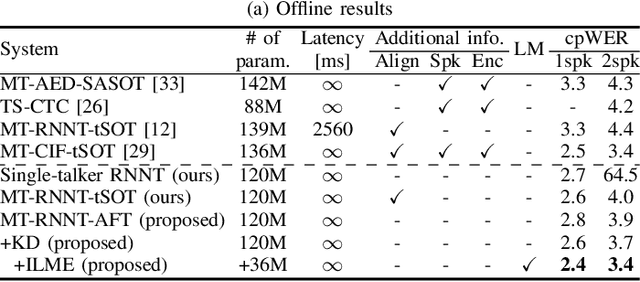

Abstract:Extending the RNN Transducer (RNNT) to recognize multi-talker speech is essential for wider automatic speech recognition (ASR) applications. Multi-talker RNNT (MT-RNNT) aims to achieve recognition without relying on costly front-end source separation. MT-RNNT is conventionally implemented using architectures with multiple encoders or decoders, or by serializing all speakers' transcriptions into a single output stream. The first approach is computationally expensive, particularly due to the need for multiple encoder processing. In contrast, the second approach involves a complex label generation process, requiring accurate timestamps of all words spoken by all speakers in the mixture, obtained from an external ASR system. In this paper, we propose a novel alignment-free training scheme for the MT-RNNT (MT-RNNT-AFT) that adopts the standard RNNT architecture. The target labels are created by appending a prompt token corresponding to each speaker at the beginning of the transcription, reflecting the order of each speaker's appearance in the mixtures. Thus, MT-RNNT-AFT can be trained without relying on accurate alignments, and it can recognize all speakers' speech with just one round of encoder processing. Experiments show that MT-RNNT-AFT achieves performance comparable to that of the state-of-the-art alternatives, while greatly simplifying the training process.
NTT Multi-Speaker ASR System for the DASR Task of CHiME-8 Challenge
Sep 09, 2024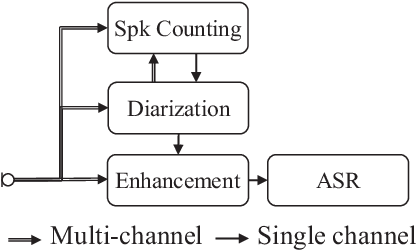
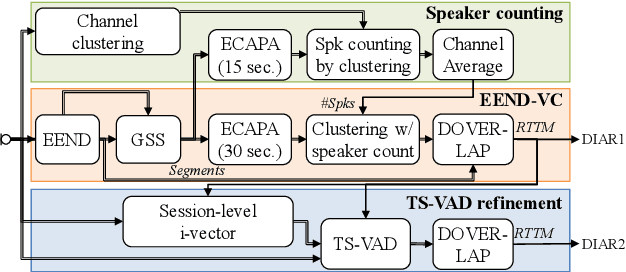


Abstract:We present a distant automatic speech recognition (DASR) system developed for the CHiME-8 DASR track. It consists of a diarization first pipeline. For diarization, we use end-to-end diarization with vector clustering (EEND-VC) followed by target speaker voice activity detection (TS-VAD) refinement. To deal with various numbers of speakers, we developed a new multi-channel speaker counting approach. We then apply guided source separation (GSS) with several improvements to the baseline system. Finally, we perform ASR using a combination of systems built from strong pre-trained models. Our proposed system achieves a macro tcpWER of 21.3 % on the dev set, which is a 57 % relative improvement over the baseline.
Sentence-wise Speech Summarization: Task, Datasets, and End-to-End Modeling with LM Knowledge Distillation
Aug 01, 2024



Abstract:This paper introduces a novel approach called sentence-wise speech summarization (Sen-SSum), which generates text summaries from a spoken document in a sentence-by-sentence manner. Sen-SSum combines the real-time processing of automatic speech recognition (ASR) with the conciseness of speech summarization. To explore this approach, we present two datasets for Sen-SSum: Mega-SSum and CSJ-SSum. Using these datasets, our study evaluates two types of Transformer-based models: 1) cascade models that combine ASR and strong text summarization models, and 2) end-to-end (E2E) models that directly convert speech into a text summary. While E2E models are appealing to develop compute-efficient models, they perform worse than cascade models. Therefore, we propose knowledge distillation for E2E models using pseudo-summaries generated by the cascade models. Our experiments show that this proposed knowledge distillation effectively improves the performance of the E2E model on both datasets.
SpeakerBeam-SS: Real-time Target Speaker Extraction with Lightweight Conv-TasNet and State Space Modeling
Jul 01, 2024


Abstract:Real-time target speaker extraction (TSE) is intended to extract the desired speaker's voice from the observed mixture of multiple speakers in a streaming manner. Implementing real-time TSE is challenging as the computational complexity must be reduced to provide real-time operation. This work introduces to Conv-TasNet-based TSE a new architecture based on state space modeling (SSM) that has been shown to model long-term dependency effectively. Owing to SSM, fewer dilated convolutional layers are required to capture temporal dependency in Conv-TasNet, resulting in the reduction of model complexity. We also enlarge the window length and shift of the convolutional (TasNet) frontend encoder to reduce the computational cost further; the performance decline is compensated by over-parameterization of the frontend encoder. The proposed method reduces the real-time factor by 78% from the conventional causal Conv-TasNet-based TSE while matching its performance.
Time-domain Speech Enhancement Assisted by Multi-resolution Frequency Encoder and Decoder
Mar 26, 2023



Abstract:Time-domain speech enhancement (SE) has recently been intensively investigated. Among recent works, DEMUCS introduces multi-resolution STFT loss to enhance performance. However, some resolutions used for STFT contain non-stationary signals, and it is challenging to learn multi-resolution frequency losses simultaneously with only one output. For better use of multi-resolution frequency information, we supplement multiple spectrograms in different frame lengths into the time-domain encoders. They extract stationary frequency information in both narrowband and wideband. We also adopt multiple decoder outputs, each of which computes its corresponding resolution frequency loss. Experimental results show that (1) it is more effective to fuse stationary frequency features than non-stationary features in the encoder, and (2) the multiple outputs consistent with the frequency loss improve performance. Experiments on the Voice-Bank dataset show that the proposed method obtained a 0.14 PESQ improvement.
Non-autoregressive Error Correction for CTC-based ASR with Phone-conditioned Masked LM
Sep 08, 2022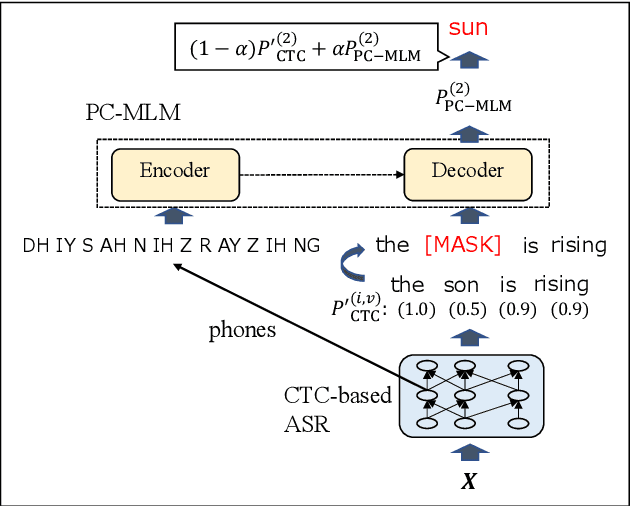
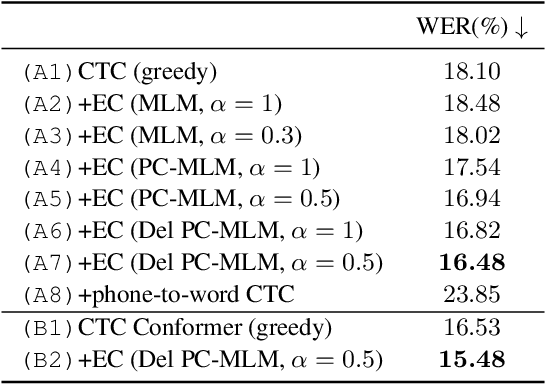
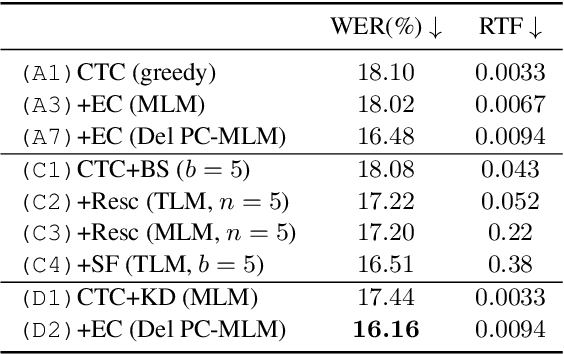
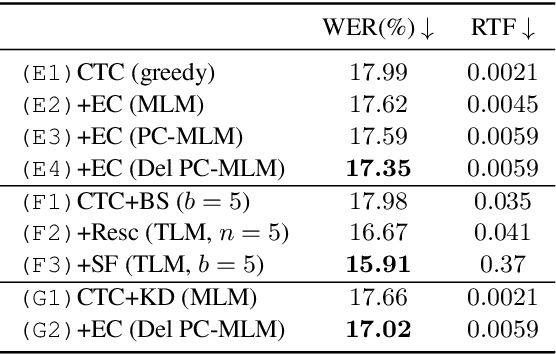
Abstract:Connectionist temporal classification (CTC) -based models are attractive in automatic speech recognition (ASR) because of their non-autoregressive nature. To take advantage of text-only data, language model (LM) integration approaches such as rescoring and shallow fusion have been widely used for CTC. However, they lose CTC's non-autoregressive nature because of the need for beam search, which slows down the inference speed. In this study, we propose an error correction method with phone-conditioned masked LM (PC-MLM). In the proposed method, less confident word tokens in a greedy decoded output from CTC are masked. PC-MLM then predicts these masked word tokens given unmasked words and phones supplementally predicted from CTC. We further extend it to Deletable PC-MLM in order to address insertion errors. Since both CTC and PC-MLM are non-autoregressive models, the method enables fast LM integration. Experimental evaluations on the Corpus of Spontaneous Japanese (CSJ) and TED-LIUM2 in domain adaptation setting shows that our proposed method outperformed rescoring and shallow fusion in terms of inference speed, and also in terms of recognition accuracy on CSJ.
Distilling the Knowledge of BERT for CTC-based ASR
Sep 05, 2022

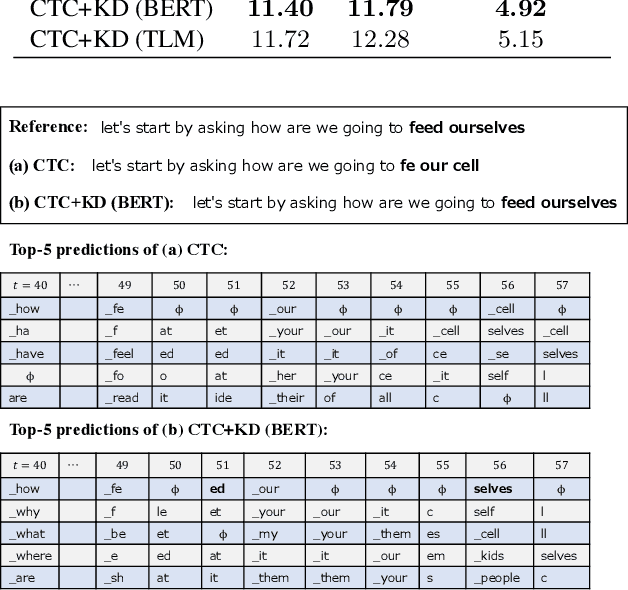

Abstract:Connectionist temporal classification (CTC) -based models are attractive because of their fast inference in automatic speech recognition (ASR). Language model (LM) integration approaches such as shallow fusion and rescoring can improve the recognition accuracy of CTC-based ASR by taking advantage of the knowledge in text corpora. However, they significantly slow down the inference of CTC. In this study, we propose to distill the knowledge of BERT for CTC-based ASR, extending our previous study for attention-based ASR. CTC-based ASR learns the knowledge of BERT during training and does not use BERT during testing, which maintains the fast inference of CTC. Different from attention-based models, CTC-based models make frame-level predictions, so they need to be aligned with token-level predictions of BERT for distillation. We propose to obtain alignments by calculating the most plausible CTC paths. Experimental evaluations on the Corpus of Spontaneous Japanese (CSJ) and TED-LIUM2 show that our method improves the performance of CTC-based ASR without the cost of inference speed.
ASR Rescoring and Confidence Estimation with ELECTRA
Oct 05, 2021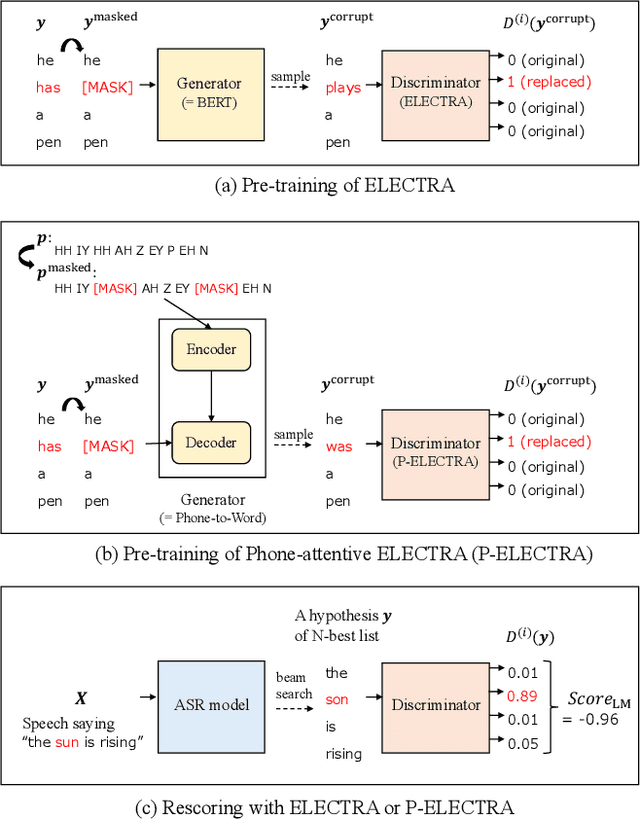

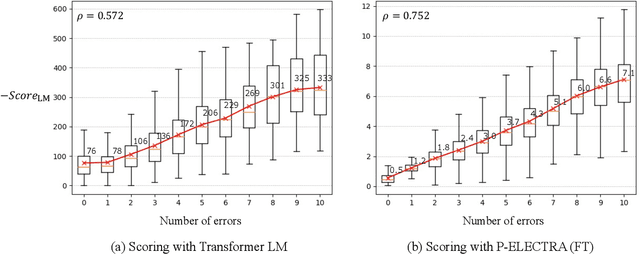

Abstract:In automatic speech recognition (ASR) rescoring, the hypothesis with the fewest errors should be selected from the n-best list using a language model (LM). However, LMs are usually trained to maximize the likelihood of correct word sequences, not to detect ASR errors. We propose an ASR rescoring method for directly detecting errors with ELECTRA, which is originally a pre-training method for NLP tasks. ELECTRA is pre-trained to predict whether each word is replaced by BERT or not, which can simulate ASR error detection on large text corpora. To make this pre-training closer to ASR error detection, we further propose an extended version of ELECTRA called phone-attentive ELECTRA (P-ELECTRA). In the pre-training of P-ELECTRA, each word is replaced by a phone-to-word conversion model, which leverages phone information to generate acoustically similar words. Since our rescoring method is optimized for detecting errors, it can also be used for word-level confidence estimation. Experimental evaluations on the Librispeech and TED-LIUM2 corpora show that our rescoring method with ELECTRA is competitive with conventional rescoring methods with faster inference. ELECTRA also performs better in confidence estimation than BERT because it can learn to detect inappropriate words not only in fine-tuning but also in pre-training.
Distilling the Knowledge of BERT for Sequence-to-Sequence ASR
Aug 09, 2020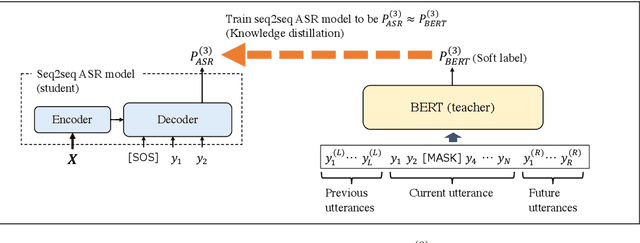

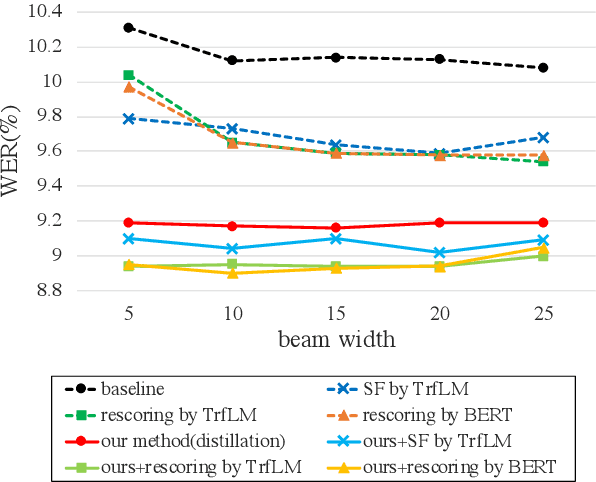
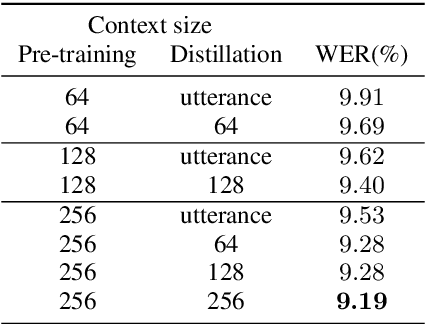
Abstract:Attention-based sequence-to-sequence (seq2seq) models have achieved promising results in automatic speech recognition (ASR). However, as these models decode in a left-to-right way, they do not have access to context on the right. We leverage both left and right context by applying BERT as an external language model to seq2seq ASR through knowledge distillation. In our proposed method, BERT generates soft labels to guide the training of seq2seq ASR. Furthermore, we leverage context beyond the current utterance as input to BERT. Experimental evaluations show that our method significantly improves the ASR performance from the seq2seq baseline on the Corpus of Spontaneous Japanese (CSJ). Knowledge distillation from BERT outperforms that from a transformer LM that only looks at left context. We also show the effectiveness of leveraging context beyond the current utterance. Our method outperforms other LM application approaches such as n-best rescoring and shallow fusion, while it does not require extra inference cost.
 Add to Chrome
Add to Chrome Add to Firefox
Add to Firefox Add to Edge
Add to Edge